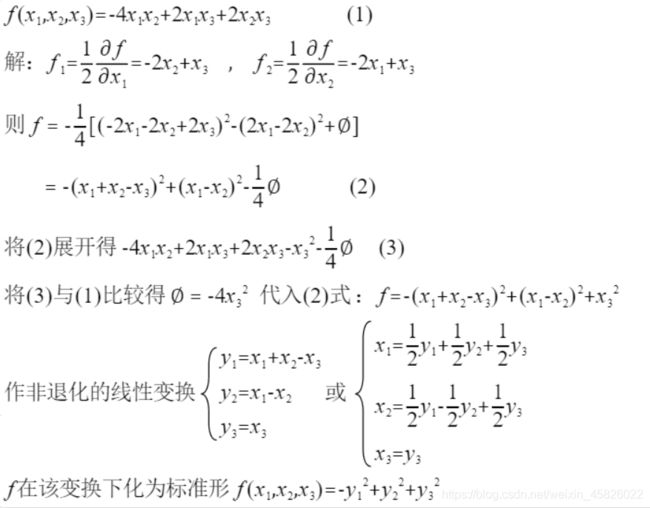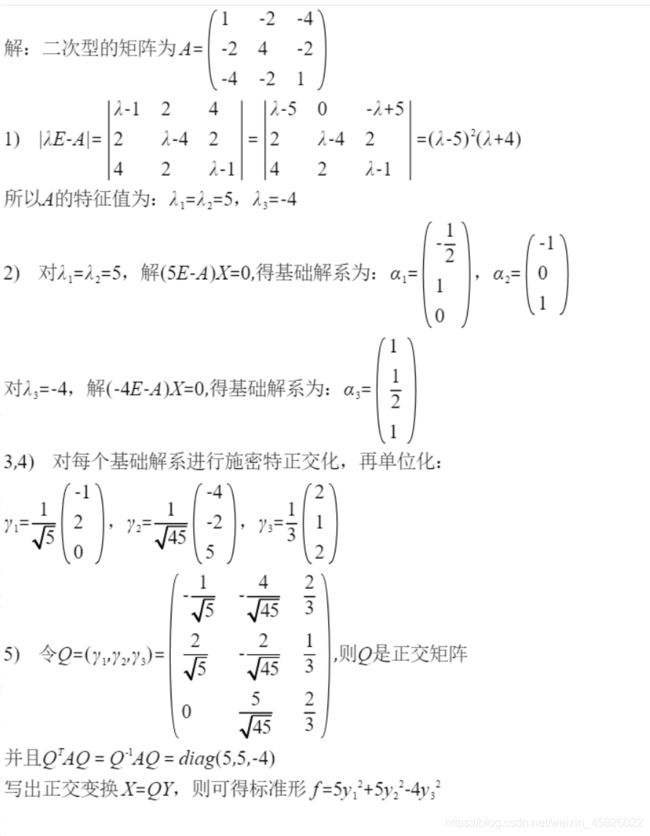二次型化标准形的五种方法
文章目录
- 1. 配方法
- 2. 初等变换法
- 3. 正交变换法
- 4. 偏导数法
- 5. 顺序主子式法
1. 配方法
用配方法化二次型为标准形的关键是消去交叉项,分如下两种情况:
- 情形1:如果二次型 f ( x 1 , x 2 , x 3 , ⋯ , x n ) {f \left( x\mathop{ {}}\nolimits_{ {1}}\text{ },\text{ }x\mathop{ {}}\nolimits_{ {2}}\text{ },\text{ }x\mathop{ {}}\nolimits_{ {3}}\text{ },\text{ } \cdots \text{ },\text{ }x\mathop{ {}}\nolimits_{ {n}} \right) } f(x1 , x2 , x3 , ⋯ , xn)含某平方项,如 x1的平方项,且 a 11 ≠ 0 {a\mathop{ {}}\nolimits_{ {11}}\text{ } \neq \text{ }0} a11 = 0 , 则合并二次型中含 x1 的所有交叉项,然后与 x12 配方,并作非退化线性变换为:
y 1 = c 11 x 1 + c 12 x 2 + ⋯ + c n n x n y 2 = x 2 ⋮ y n = x n {y\mathop{ {}}\nolimits_{ {1}}\text{ }=\text{ }c\mathop{ {}}\nolimits_{ {11}}x\mathop{ {}}\nolimits_{ {1}}\text{ }+\text{ }c\mathop{ {}}\nolimits_{ {12}}x\mathop{ {}}\nolimits_{ {2}}\text{ }+\text{ } \cdots \text{ }+\text{ }c\mathop{ {}}\nolimits_{ {nn}}x\mathop{ {}}\nolimits_{ {n}}}\\ {y\mathop{ {}}\nolimits_{ {2}}\text{ }=\text{ }x\mathop{ {}}\nolimits_{ {2}}}\\ { \vdots }\\ {y\mathop{ {}}\nolimits_{ {n}}\text{ }=\text{ }x\mathop{ {}}\nolimits_{ {n}}} y1 = c11x1 + c12x2 + ⋯ + cnnxny2 = x2⋮yn = xn
- 得 f = d 1 y 1 2 + g ( y 2 , ⋯ , y n ) {f\text{ }=\text{ }d\mathop{ {}}\nolimits_{ {1}}y\mathop{ {}}\nolimits_{ {1}}\mathop{ {}}\nolimits^{ {2}}\text{ }+\text{ }g \left( y\mathop{ {}}\nolimits_{ {2}}\text{ },\text{ } \cdots \text{ },\text{ }y\mathop{ {}}\nolimits_{ {n}} \right) } f = d1y12 + g(y2 , ⋯ , yn) , 其中 g ( y 2 , ⋯ , y n ) {g \left( y\mathop{ {}}\nolimits_{ {2}}\text{ },\text{ } \cdots \text{ },\text{ }y\mathop{ {}}\nolimits_{ {n}} \right) } g(y2 , ⋯ , yn) 是 y 2 , ⋯ , y n {y\mathop{ {}}\nolimits_{ {2}}\text{ },\text{ } \cdots \text{ },\text{ }y\mathop{ {}}\nolimits_{ {n}}} y2 , ⋯ , yn 的二次型。对于 g ( y 2 , ⋯ , y n ) {g \left( y\mathop{ {}}\nolimits_{ {2}}\text{ },\text{ } \cdots \text{ },\text{ }y\mathop{ {}}\nolimits_{ {n}} \right) } g(y2 , ⋯ , yn) 重复上述方法,直到化为二次型 f 为标准形为止。
例1: f ( x 1 , x 2 , x 3 , x 4 ) {f \left( x\mathop{ {}}\nolimits_{ {1}}\text{ },\text{ }x\mathop{ {}}\nolimits_{ {2}}\text{ },\text{ }x\mathop{ {}}\nolimits_{ {3}}\text{ },\text{ }x\mathop{ {}}\nolimits_{ {4}} \right) } f(x1 , x2 , x3 , x4) = x 1 2 + 4 x 1 x 2 − 2 x 1 x 4 + 3 x 2 2 − {x\mathop{ {}}\nolimits_{ {1}}\mathop{ {}}\nolimits^{ {2}}+4x\mathop{ {}}\nolimits_{ {1}}x\mathop{ {}}\nolimits_{ {2}}-2x\mathop{ {}}\nolimits_{ {1}}x\mathop{ {}}\nolimits_{ {4}}+3x\mathop{ {}}\nolimits_{ {2}}\mathop{ {}}\nolimits^{ {2}}-} x12+4x1x2−2x1x4+3x22− 2 x 2 x 3 − 6 x 2 x 4 + 2 x 3 x 4 + 4 x 4 2 {2x\mathop{ {}}\nolimits_{ {2}}x\mathop{ {}}\nolimits_{ {3}}-6x\mathop{ {}}\nolimits_{ {2}}x\mathop{ {}}\nolimits_{ {4}}+2x\mathop{ {}}\nolimits_{ {3}}x\mathop{ {}}\nolimits_{ {4}}+4x\mathop{ {}}\nolimits_{ {4}}\mathop{ {}}\nolimits^{ {2}}} 2x2x3−6x2x4+2x3x4+4x42 用配方法将上式化为标准形,并写出所作的非退化线性变换及其矩阵。
注:此题中它的标准形为 f = z 1 2 − z 2 2 + z 3 2 {f=z\mathop{ {}}\nolimits_{ {1}}\mathop{ {}}\nolimits^{ {2}}-z\mathop{ {}}\nolimits_{ {2}}\mathop{ {}}\nolimits^{ {2}}+z\mathop{ {}}\nolimits_{ {3}}\mathop{ {}}\nolimits^{ {2}}} f=z12−z22+z32,它还是四元二次型,只是 z 4 2 {z\mathop{ {}}\nolimits_{ {4}}\mathop{ {}}\nolimits^{ {2}}} z42的系数为零,所作的线性变换式(2)必须有 y4 = z4 项,否则不是非退化线性变换。
- 情形2:如果二次型 f ( x 1 , x 2 , x 3 , ⋯ , x n ) {f \left( x\mathop{ {}}\nolimits_{ {1}}\text{ },\text{ }x\mathop{ {}}\nolimits_{ {2}}\text{ },\text{ }x\mathop{ {}}\nolimits_{ {3}}\text{ },\text{ } \cdots \text{ },\text{ }x\mathop{ {}}\nolimits_{ {n}} \right) } f(x1 , x2 , x3 , ⋯ , xn)不含平方项,即 aij=0,但含某一个 aij ≠ 0(i ≠ j),则可做非退化线性变换
xi = yi + yj
xj = yi - yj , (k=1,2,….,n ; k ≠ i , j)
xk = yk
- 把 f 化为一个含有平方项 yi2 的二次型,再用情形1的方法将其化为标准形。
例2: f ( x 1 , x 2 , x 3 ) = x 1 x 2 + x 1 x 3 + x 2 x 3 {f \left( x\mathop{ {}}\nolimits_{ {1}}\text{ },\text{ }x\mathop{ {}}\nolimits_{ {2}}\text{ },\text{ }x\mathop{ {}}\nolimits_{ {3}} \left) =x\mathop{ {}}\nolimits_{ {1}}x\mathop{ {}}\nolimits_{ {2}}+x\mathop{ {}}\nolimits_{ {1}}x\mathop{ {}}\nolimits_{ {3}}+x\mathop{ {}}\nolimits_{ {2}}x\mathop{ {}}\nolimits_{ {3}}\right. \right. } f(x1 , x2 , x3)=x1x2+x1x3+x2x3,用配方法将此式化为标准形,并写出所用的非退化线性变换。
2. 初等变换法
初等变换法如下:
- 第一步写出二次型的矩阵 A,并构造 2n×n 矩阵 ( A E ) {A \choose E} (EA)
- 对 A 进行初等行变换和同样的初等列变换(不可交换两行或两列的位置),把A化为对角矩阵D,并对E施行与A相同的初等列变换(切记E并不进行初等行变换),将E化为矩阵C,此时 C’AC = D
- 第三步写出非退化线性变换 x = Cy,化二次型为标准形 f = y’Dy
补充 ,若第一步构造 n×2n矩阵 (A E),则第二步将A化为对角矩阵D,并对E施行与A相同的初等行变换 ,将E化为矩阵C,此时C不是我们需要的非退化矩阵!!!对矩阵C进行转置 得到 矩阵F = C’ ,此时矩阵F才是我们求的非退化矩阵! F’AF = D
例3:用非退化线性替换化 f ( x 1 , x 2 , x 3 ) = x 1 2 + 2 x 1 x 2 + {f \left( x\mathop{ {}}\nolimits_{ {1}},x\mathop{ {}}\nolimits_{ {2}},x\mathop{ {}}\nolimits_{ {3}} \left) =x\mathop{ {}}\nolimits_{ {1}}\mathop{ {}}\nolimits^{ {2}}+2x\mathop{ {}}\nolimits_{ {1}}x\mathop{ {}}\nolimits_{ {2}}+\right. \right. } f(x1,x2,x3)=x12+2x1x2+ 2 x 2 2 + 4 x 2 x 3 + 4 x 3 2 {2x\mathop{ {}}\nolimits_{ {2}}\mathop{ {}}\nolimits^{ {2}}+4x\mathop{ {}}\nolimits_{ {2}}x\mathop{ {}}\nolimits_{ {3}}+4x\mathop{ {}}\nolimits_{ {3}}\mathop{ {}}\nolimits^{ {2}}} 2x22+4x2x3+4x32 为标准形,并利用矩阵验算所得结果。
3. 正交变换法
主轴定理 : 任给二次型 f = ∑ i , j = 1 n a i j x i x j ( a i j = a j i ) {f={\mathop{ \sum }\limits_{ {i,j=1}}^{ {n}}{a\mathop{ {}}\nolimits_{ {ij}}x\mathop{ {}}\nolimits_{ {i}}x\mathop{ {}}\nolimits_{ {j}}\text{ } \left( a\mathop{ {}}\nolimits_{ {ij}}=a\mathop{ {}}\nolimits_{ {ji}} \right) }}} f=i,j=1∑naijxixj (aij=aji),总有正交变换 x = Py,使 f 化为标准形 f = λ 1 y 1 2 + λ 2 y 2 2 + ⋯ + λ n y n 2 { {f= \lambda \mathop{ {}}\nolimits_{ {1}}y\mathop{ {}}\nolimits_{ {1}}\mathop{ {}}\nolimits^{ {2}}+ \lambda \mathop{ {}}\nolimits_{ {2}}y\mathop{ {}}\nolimits_{ {2}}\mathop{ {}}\nolimits^{ {2}}}+ \cdots + \lambda \mathop{ {}}\nolimits_{ {n}}y\mathop{ {}}\nolimits_{ {n}}\mathop{ {}}\nolimits^{ {2}}} f=λ1y12+λ2y22+⋯+λnyn2 ,其中 λ 1 , λ 2 , ⋯ , λ n { \lambda \mathop{ {}}\nolimits_{ {1}}, \lambda \mathop{ {}}\nolimits_{ {2}}, \cdots , \lambda \mathop{ {}}\nolimits_{ {n}}} λ1,λ2,⋯,λn 是矩阵 A = (aij) 的特征值
步骤如下:
- 写出二次型的矩阵 A
- 求出 A 的特征值,得 λ 1 , λ 2 , ⋯ , λ n { \lambda \mathop{ {}}\nolimits_{ {1}}, \lambda \mathop{ {}}\nolimits_{ {2}}, \cdots , \lambda \mathop{ {}}\nolimits_{ {n}}} λ1,λ2,⋯,λn
- 求出对应的特征向量
- 将特征向量作施密特正交变换,得到正交的特征向量
- 将正交的特征向量单位化
- 将这些单位化向量排成矩阵,得到正交矩阵 Q
例4:用正交变换化二次型为标准形,并求出所用的正交变换 f ( x 1 , x 2 , x 3 ) = x 1 2 + 4 x 2 2 + x 3 2 {f \left( x\mathop{ {}}\nolimits_{ {1}},x\mathop{ {}}\nolimits_{ {2}},x\mathop{ {}}\nolimits_{ {3}} \left) =x\mathop{ {}}\nolimits_{ {1}}\mathop{ {}}\nolimits^{ {2}}+4x\mathop{ {}}\nolimits_{ {2}}\mathop{ {}}\nolimits^{ {2}}+x\mathop{ {}}\nolimits_{ {3}}\mathop{ {}}\nolimits^{ {2}}\right. \right. } f(x1,x2,x3)=x12+4x22+x32 − 4 x 1 x 2 − 8 x 1 x 3 − 4 x 2 x 3 {-4x\mathop{ {}}\nolimits_{ {1}}x\mathop{ {}}\nolimits_{ {2}}-8x\mathop{ {}}\nolimits_{ {1}}x\mathop{ {}}\nolimits_{ {3}}-4x\mathop{ {}}\nolimits_{ {2}}x\mathop{ {}}\nolimits_{ {3}}} −4x1x2−8x1x3−4x2x3
4. 偏导数法
例5:将二次型 f ( x 1 , x 2 , x 3 ) = − 4 x 1 x 2 + 2 x 1 x 3 + 2 x 2 x 3 {f \left( x\mathop{ {}}\nolimits_{ {1}},x\mathop{ {}}\nolimits_{ {2}},x\mathop{ {}}\nolimits_{ {3}} \left) =-4x\mathop{ {}}\nolimits_{ {1}}x\mathop{ {}}\nolimits_{ {2}}+2x\mathop{ {}}\nolimits_{ {1}}x\mathop{ {}}\nolimits_{ {3}}+2x\mathop{ {}}\nolimits_{ {2}}x\mathop{ {}}\nolimits_{ {3}}\right. \right. } f(x1,x2,x3)=−4x1x2+2x1x3+2x2x3 化为标准形,并写出所作的非退化线性变换。

5. 顺序主子式法

这种方法限制很大,第一:二次型的前n-1个顺序主子式可能出现0。第二:该方法不能直接算出非退化的变换矩阵。
例6:将二次型 f ( x 1 , x 2 , x 3 ) = x 1 2 + 5 x 1 x 2 − 4 x 2 x 3 {f \left( x\mathop{ {}}\nolimits_{ {1}},x\mathop{ {}}\nolimits_{ {2}},x\mathop{ {}}\nolimits_{ {3}} \left) =x\mathop{ {}}\nolimits_{ {1}}\mathop{ {}}\nolimits^{ {2}}+5x\mathop{ {}}\nolimits_{ {1}}x\mathop{ {}}\nolimits_{ {2}}-4x\mathop{ {}}\nolimits_{ {2}}x\mathop{ {}}\nolimits_{ {3}}\right. \right. } f(x1,x2,x3)=x12+5x1x2−4x2x3 化为标准形。





